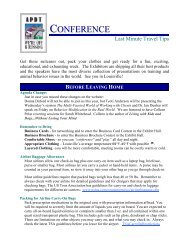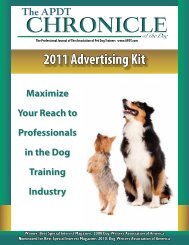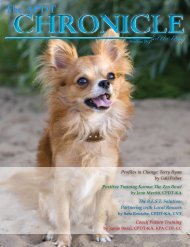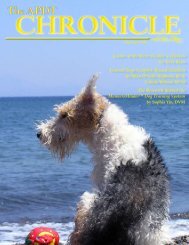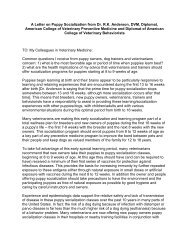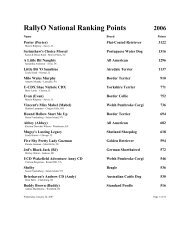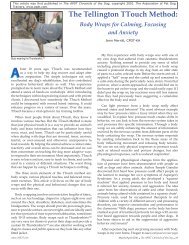of the Dog - Association of Pet Dog Trainers
of the Dog - Association of Pet Dog Trainers
of the Dog - Association of Pet Dog Trainers
Create successful ePaper yourself
Turn your PDF publications into a flip-book with our unique Google optimized e-Paper software.
Wide Panting:<br />
When <strong>the</strong> dog’s mouth is parted extra wide, without<br />
having his lips retracted while he brea<strong>the</strong>s with his mouth<br />
open.<br />
Yawn, no teeth<br />
Yawn — Regular:<br />
When <strong>the</strong> dog yawns.<br />
Yawn With Teeth Exposed:<br />
When <strong>the</strong> dog yawns and flashes all or most <strong>of</strong> <strong>the</strong> teeth<br />
in his mouth during <strong>the</strong> widest part <strong>of</strong> <strong>the</strong> yawn.<br />
Common Clusters <strong>of</strong> Behaviors:<br />
The Scent Marking Cluster:<br />
I frequently see Shoulder Rubbing, Flying Shoulder<br />
Rubs, Shoulder Stance and all <strong>the</strong> Anal Touching/Swiping<br />
behaviors occurring toge<strong>the</strong>r. These behaviors tend to<br />
occur in <strong>the</strong> least sociable dogs, and commonly in dogs<br />
who fail one or more portions <strong>of</strong> <strong>the</strong> test. I interpret <strong>the</strong>se<br />
behaviors as a form <strong>of</strong> scent marking.<br />
Anus Behaviors:<br />
Initially, I began to notice merely that some dogs would<br />
sit on my shoe during testing. Then I would notice that<br />
sometimes this would “gross me out” or disgust me, which<br />
I found interesting since I am usually not in any way<br />
disgusted by dogs. I <strong>the</strong>n noticed that <strong>the</strong> dogs who sat<br />
on my shoe and disgusted me would position <strong>the</strong>mselves<br />
in such a way that I could feel <strong>the</strong>ir anus on <strong>the</strong> top <strong>of</strong> my<br />
shoes. O<strong>the</strong>r dogs, with whom I was not disgusted, would<br />
position <strong>the</strong>ir tails or rear legs in such a way that <strong>the</strong>y could<br />
sit on my shoe without <strong>the</strong>ir anus making contact. It had<br />
nothing to do with tail set, tail type, or tail carriage. Then<br />
I began to notice that <strong>the</strong> dogs whose anuses made contact<br />
were typically <strong>the</strong> least sociable dogs who commonly failed<br />
one or more parts <strong>of</strong> <strong>the</strong> full assessment. The most sociable<br />
dogs hardly ever touched <strong>the</strong>ir anuses to me or any o<strong>the</strong>r<br />
place in <strong>the</strong> testing environment. Anal glands are known<br />
for scent marking in dogs, and it seems to me that a dog<br />
who swipes his anus all over <strong>the</strong> tester and furniture in <strong>the</strong><br />
testing room, could, like graffiti, be tagging his signature,<br />
claiming ownership <strong>of</strong> all <strong>the</strong>se things.<br />
www.APDT.com<br />
I was recently watching an episode <strong>of</strong> Meerkat Manor<br />
on Animal Planet, and was thrilled and astounded to<br />
see <strong>the</strong> first reference in any mammal, to anal marking.<br />
It was described as an “attack” and considered part <strong>of</strong> a<br />
dominance take-over by one meerkat to her injured sister.<br />
Although <strong>the</strong>re was no biting or actual injury, <strong>the</strong> one<br />
meerkat repeatedly anal-swiped and shoulder rubbed all<br />
over <strong>the</strong> o<strong>the</strong>r meerkat.<br />
Scent Marking and Resource Guarding:<br />
I also see a strong correlation between <strong>the</strong>se “scentmarking”<br />
behaviors and dogs who fail <strong>the</strong> resource<br />
guarding portions and sometimes <strong>the</strong> stranger tests.<br />
It seems to me that whe<strong>the</strong>r it is a human-to-human<br />
relationship or a dog-to-human relationship, <strong>the</strong> healthiest<br />
and least risky relationships are ones based significantly<br />
on respect, friendship, love, shared joy, etc. and <strong>the</strong> most<br />
risky, least healthy relationships are ones where <strong>the</strong><br />
majority <strong>of</strong> <strong>the</strong> relationship is based on treating <strong>the</strong> o<strong>the</strong>r<br />
as property, or as if <strong>the</strong> o<strong>the</strong>r is “owned.” I wonder if, when<br />
a dog shows no sociability, but scent marks <strong>the</strong> tester and<br />
<strong>the</strong> furniture in <strong>the</strong> testing room throughout, whe<strong>the</strong>r he<br />
is claiming <strong>the</strong>se as his own property, tagging <strong>the</strong>m as<br />
resources to guard.<br />
Most Dangerous Pr<strong>of</strong>ile:<br />
I consider <strong>the</strong> large, muscular, non—sociable dog<br />
who shows many “scent marking” behaviors as <strong>the</strong><br />
most dangerous type <strong>of</strong> dog. I believe dogs that are both<br />
physically large and strong, as well as show no attachment<br />
to humans, but rub on <strong>the</strong>m with <strong>the</strong>ir shoulders and<br />
anus, have <strong>the</strong> most potential for harm. To me, <strong>the</strong>se are<br />
not in any way “pet” or “companion” dogs, but ra<strong>the</strong>r<br />
predators. I also believe that it is, in part sociability (along<br />
with training, relationship, bonding, and bite-inhibition<br />
training) that helps a dog inhibit his bite if and when <strong>the</strong><br />
dog was to get aggressive.<br />
Pediatric Spay/Neuters:<br />
As a very new observation, one that I am still just a<br />
spectator <strong>of</strong>, is I see an abundance <strong>of</strong> what I consider<br />
“scent marking” behaviors in adolescent and adult dogs<br />
suspected <strong>of</strong>, or known to have been, a pediatric spay or<br />
neuter. Pediatric spay and neuter I define as sterilization<br />
performed before six months <strong>of</strong> age. I haven’t seen enough<br />
suspected or known pediatric spay/neuters to really amass<br />
enough observations, except that I have, so far, been pretty<br />
consistently making <strong>the</strong>se observations on <strong>the</strong> ones I do<br />
see.<br />
Intense Sniffing and <strong>Dog</strong>-to-<strong>Dog</strong> Aggression:<br />
I have noted that dogs who sniff one spot for three<br />
seconds or longer and do so more than once during<br />
testing, are more likely have dog-to-dog aggression issues.<br />
I have noticed during behavior consultations as well that<br />
dogs who have issues with o<strong>the</strong>r dogs are most likely to<br />
come into <strong>the</strong> consultation room and [continued on next page]<br />
November/December 2008 w The APDT Chronicle <strong>of</strong> <strong>the</strong> <strong>Dog</strong> w 45<br />
An Ethogram <strong>of</strong> <strong>the</strong> Shelter <strong>Dog</strong>



